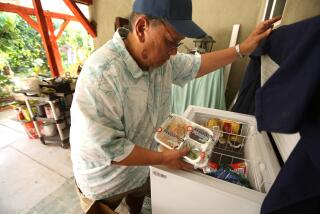Station Wagon Brings Service to Indigents : Lunch Program Moves to Beach
- Share via
Four months after the St. Joseph Center closed its free lunch line because of complaints from neighbors, volunteers from the Venice-based charity organization have resumed the program at a beachfront parking lot.
The handouts began with little fanfare last week, but word spread quickly among the homeless people who frequent the beach area.
Operating five days a week, the program attracts about 100 people a day with sandwiches, fruit and coffee handed out from the back of a station wagon parked a few feet from the sand near the corner of Rose Avenue and Ocean Front Walk.
“So far it’s gone very smoothly,” said John Redder, who coordinated the program for the center, a Catholic-led organization that operates independently of the church’s charity system.
“This is the best thing that’s happened out here,” said Albert Heredia, who said he has been living on the beach for the last two years.
Some nearby merchants were less enthusiastic about the program, however.
“They’re a bunch of freeloaders. They should go to work for a living,” said Al Rosa, owner of the L & A Market, which faces the beach near the corner of Rose Avenue. But he said he did not expect the program to hurt his business.
Although about 25 people were in line near the station wagon before opening time Wednesday, the program was barely noticeable once it got under way.
People walked up to the car and spoke briefly with the volunteers, who took down their names and used the opportunity to tell them about the center, which tries to find housing, counseling and other other services for the indigent.
Then they were offered a choice of cheese or peanut butter sandwiches, accompanied by apples, fruit juice and coffee.
Most of the food came from donations, Redder said. It was prepared by volunteers at a caterer’s kitchen, then wrapped and stored overnight in a refrigerator in accordance with county health regulations.
He said the new site was chosen after neighbors complained about health code violations at the lunch program’s old location, in the back of the St. Joseph Center at 4th Street and Rose Avenue.
The building had been gutted by a fire of mysterious origin in February, but volunteers continued to prepare food at their homes and dispense it behind the center until the neighbors complained to the county health department about noise and dirty conditions.
Those complaints have stopped, said Pearl White, a community activist and leader of the Oakwood Community Center who was vehemently opposed to the lunch program at its old location.
“We’re not against the St. Joseph Center, we’re just against the element they were bringing into the area,” she said.
Prompted by the complaints, Redder said he conferred with county officials and concluded that serving food from a vehicle would be easier than remodeling the center’s small building to meet the requirements for a restaurant kitchen.
Staffers from Supervisor Deane Dana’s office were then consulted to arrange for use of the lot, which is generally empty on weekday mornings.
If demand continues to grow, a limit of 150 meals a day may have to be instituted, Redder said. No seconds are allowed.
According to figures from the first two weeks of operation, three-fourths of those using the lunch service had spent the previous night without shelter in Venice, either on the street or on the beach.
Two-thirds of the group had been homeless more than six weeks. The ratio of men to women was 6 to 1.
A countywide task force recently concluded that the homeless population on the Westside is about 2,750. Earlier estimates put the total as high as 5,000.
More to Read
Sign up for Essential California
The most important California stories and recommendations in your inbox every morning.
You may occasionally receive promotional content from the Los Angeles Times.













